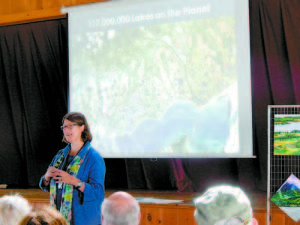Lakes speak loudly on climate change

LISA BORRE — lake researcher from the Cary Institute of Ecosystem Studies, addresses the crowd at this year’s Maine Lakes Conference at Camp Skylemar in Naples. (Geraghty Photo)
By Gail Geraghty
Staff Writer
With over 117 billion lakes on Planet Earth, you’d think their declining status would merit serious attention in current studies on climate change.
But in the latest National Climate Assessment, an 800-page report by 300 authors, the chapter on water resources only has one page devoted to the effects on water quality on lakes and rivers.
That was a shocker for Lisa Borre, keynote speaker at the Aug. 22 Maine Lakes Conference held at Camp Skylemar in Naples.
“I started word-searching by chapter. Lakes are barely mentioned,†Borre told the gathering of lake and watershed associations from around the state. When she got to the national summary on lakes assessment, she said she began thinking the authors “took happy pills.†The assessment concluded that 56% of U.S. lakes are in good condition, with 21% fair and 22% in poor shape.
“What about the other 46%†said Borre, who is with the Cary Institute of Ecosystem Studies. Lake management efforts need to start seriously considering how to adapt to climate change, she said, “and build resilience of lake ecosystems to weather the changes already underway.â€
Borre said “Lakes are already feeling the effects of climate change, and science needs to catch up with that.†Over the past 25 years, she said, lake temperatures have increased on 95% of the lakes around the world.
“In some lakes, the water temperatures are increasing twice as fast as the surrounding air,†said Borre. “We need to listen to lakes. They are a more accurate indicator of climate change than nearly anything else.â€
For example, over the period from 2000 to 2015, “Lake Champlain did not freeze over nine of those years.â€
On average, ice-out on Maine’s lakes is around two weeks earlier than it was in 2000, said Borre. Other indicators that the Earth is warming as seen in increased flooding and extreme rain events happening more and more frequently.
As lakes become warmer, their stratification season, when algae flourishes, is becoming longer, Borre said. “Climate change is impacting the lake nutrients and thus stressing the fish.†Stressors are coming from many sources, including phosphorus loading, exacerbating the effects of warmer temperatures on lakes.
Borre said it is frustrating for her that the current mindset is to point the finger at just one source, such as farmers that are blamed for the Toledo water crisis. “No one was looking at the whole system,†she said. The U.S. still doesn’t have a national program to track algae blooms, she added, something that could help with mitigation efforts.
The effects of hurricanes and other major weather disruptions on water quality should also be studied, she said. “It takes months for a lake to restabilize itself after all those sediments are stirred up.â€
She encouraged conference attendees to become involved with the Global Lake Ecology Observatory Network, or GLEON, which is working to establish large-scale monitoring and tracking networks.
“GLEON is looking for citizen scientists, looking for eyes on the ground. I love the theme of this conference, stand up for lakes. I think Maine’s lake association members are up to this task.â€

